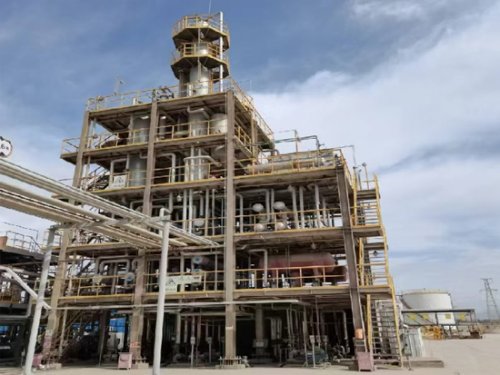
In the modern petrochemical industry, wax oil hydrodewaxing equipment plays a crucial role. Its primary function is to remove wax and impurities from wax oil through hydrogenation, thereby improving product quality and performance. This article provides an in-depth analysis of the working principles and process flow of wax oil hydrodewaxing equipment to help businesses understand the functionality and applications of this essential technology, enabling them to make informed investment decisions.

I. Working Principle of Wax Oil Hydrodewaxing Equipment
Wax oil hydrodewaxing equipment removes wax content from wax oil primarily through a hydrogenation reaction. The working principle involves the following steps:
1.Raw Material Pretreatment
Before the hydrodewaxing process begins, the wax oil undergoes pretreatment. This step includes filtration and heating to remove solid particles and moisture from the raw material, ensuring the smooth progress of the subsequent reaction.
2.Hydrogenation Reaction
After pretreatment, the wax oil is sent to a hydrogenation reactor. Inside the reactor, the wax oil reacts with hydrogen under high-temperature and high-pressure conditions. The primary goal of this hydrogenation reaction is to convert the wax into lighter hydrocarbons, thereby removing wax and other impurities.
3.Catalyst Action
Catalysts play a critical role in the hydrogenation reaction process. Common catalysts include metals such as nickel, molybdenum, and chromium, which accelerate the hydrogenation reaction and improve dewaxing efficiency.
4.Separation and Processing
The mixture after the reaction contains dewaxed oil, hydrogen gas, and removed wax. The separation unit is used to separate the liquid-phase wax oil, which further removes the wax and other impurities. Meanwhile, the separated hydrogen gas can be recycled to enhance production efficiency.
5.Post-Treatment
The separated wax oil undergoes further post-treatment, such as degassing, cooling, and filtration, to ensure that the product meets the desired quality standards.
II. Process Flow of Wax Oil Hydrodewaxing
The wax oil hydrodewaxing process typically includes the following key stages:
1.Raw Material Preparation
The wax oil is pretreated to remove solid particles and moisture, ensuring a smooth hydrogenation reaction. The pretreatment process involves heating and filtration.
2.Hydrogenation Reaction
The pretreated wax oil reacts with hydrogen in the hydrogenation reactor. The reactor maintains a high-temperature and high-pressure environment, and the catalyst facilitates the conversion of wax into lighter hydrocarbons.
3.Separation Process
The mixture after the reaction undergoes separation. This process separates liquid-phase wax oil from gaseous hydrogen, and removes wax and other impurities.
4.Hydrogen Recovery
The separated hydrogen is cooled, purified, and recycled, reducing production costs and improving economic efficiency.
5.Product Treatment
The separated wax oil is subjected to cooling, filtration, and other post-treatment processes to ensure that the final product meets quality standards.
III. Technical Advantages of Wax Oil Hydrodewaxing Equipment
1.Efficient Dewaxing
Wax oil hydrodewaxing equipment efficiently removes wax, improving product quality to meet various industrial applications.
2.Energy-Saving and Environmentally Friendly
Modern hydrodewaxing equipment is designed with optimized technology to achieve low energy consumption and high efficiency, meeting environmental standards and reducing pollutant emissions during production.
3.Automated Control
Advanced hydrodewaxing equipment is equipped with automated control systems, allowing real-time monitoring and adjustment of reaction conditions, enhancing production stability and efficiency.
4.Long Service Life and Low Maintenance
The equipment is designed for durability and stability, and the selection of catalysts and optimization of reaction conditions result in a longer service life and reduced maintenance costs.
5.Significant Economic Benefits
The efficient dewaxing process and hydrogen recovery system can significantly reduce production costs and increase economic benefits.
IV. Tips for Choosing the Right Wax Oil Hydrodewaxing Equipment
1.Evaluate Production Needs
Choose equipment specifications and configurations based on the nature of the wax oil and production scale.
2.Assess Technical Performance
Pay attention to the dewaxing efficiency, energy consumption, and catalyst life of the equipment to ensure it meets production requirements.
3.Consider Supplier Reputation
Select a reputable equipment supplier to ensure reliable equipment quality and after-sales service.
4.Analyze Return on Investment
Consider the equipment's initial cost, operating costs, and economic benefits to make a sound investment decision.
V. Conclusion
Wax oil hydrodewaxing equipment plays a key role in improving wax oil product quality and meeting environmental requirements. Understanding its working principles and process flow can help businesses choose the right equipment to achieve efficient production and sustainable development. We hope this article provides valuable insights into selecting wax oil hydrodewaxing equipment, helping companies succeed in a competitive market.



